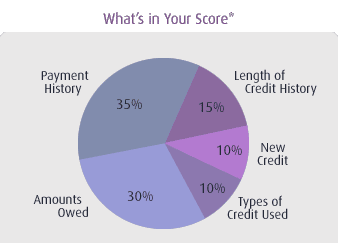I find the concept of the credit score to be very interesting. It’s a single number which to a degree is an indicator of how good a credit risk you are to a lender.
Yet, in some sense, it tells as little about an individual as a high school grade point average does. I graduated high school with an A average. On a number scale this was 90% or greater. Yet, I barely passed language and social studies. My math and science grades were always mid to high 90’s and that’s what brought up my average. In senior year when I needed just 4 classes to graduate, I took 7, 4 of which were math and science in a calculated effort to get my overall average where I wanted. Gym? The gym teacher had one rule – football players got an A, everyone else got a B if they showed up. In senior year, I wised up, I told the football coach I’d tutor his team in math if he’d recommend me for an A in gym. But I digress.
Your Credit Score (otherwise known as FICO score) ranges from 300-850. Let’s take a look at what impacts your score. Payment history, or on-time payment stands to reason. If you have a track record of paying your bills on time, you are more likely to continue doing so. Length of credit history is a tough one. I’ve had credit for 30 years now, yet when I look at my report card as offered by Credit Karma, I find that my average age of open credit lines is only 6 years 4 months. My oldest account is only 13 years 5 months old, and I suspect it’s for my original mortgage on the house we’re in. It was refinanced and 10 years after closing it will fall off the report. This component of the score is the one that has me shaking my head a bit. It would seem that getting rid of old cards you don’t use should be a good thing, it both reduces the risk of a card getting lost or stolen, and it simplifies your finances. If you have multiple cards, more than you think you’ll ever need, it’s a good idea to check your credit score first and cancel them slowly, one by one, to be sure you are not impacting your score too badly.
Amounts owed refers to the percent credit utilization. When I checked mine I found a 6% utilization, but only because I have some pretty high limits. Even though I pay all charges in full every month, if I only had one card and it had a $5000 limit, charging $3000 each month would be a negative. Just like my average high school grades didn’t reflect any one strength, card utilization doesn’t show whether the debt is the same every month or paid in full. With such a low percent used, I’ve nothing to worry about, but I’m curious if I can impact that by paying the bulk of the amount owed just before the bill is cut. If I do that, I’ll update and let my readers know how that worked out. I imagine the card issuers are not reporting real time or mid cycle, but I may be wrong there.
A few points may not impact your cost of borrowing, unless the score is low to begin with and those point bring you over the next threshold. If a loan is in your future, better to take a look at your credit score now and work to improve that score before applying for the loan. Thew lower rate you’ll get will be worth the effort.
Joe


Sounds like an “I love debt score” as Dave Ramsey always says. It would be nice to get to the point where your credit score is no longer a factor in your decisions. In some ways you can make that choice, in other ways it is hard hard road. Interesting topic. Thanks for sharing!
About 10 years ago I canceled a high-credit limit credit card that I had for over 10 years simply because I decided it would be better for me to consolidate the number of credit card accounts I had from two to one.
Yeah. I’m a knucklehead, Joe. Still kicking myself over that one.
Best,
Len
Len Penzo dot Com